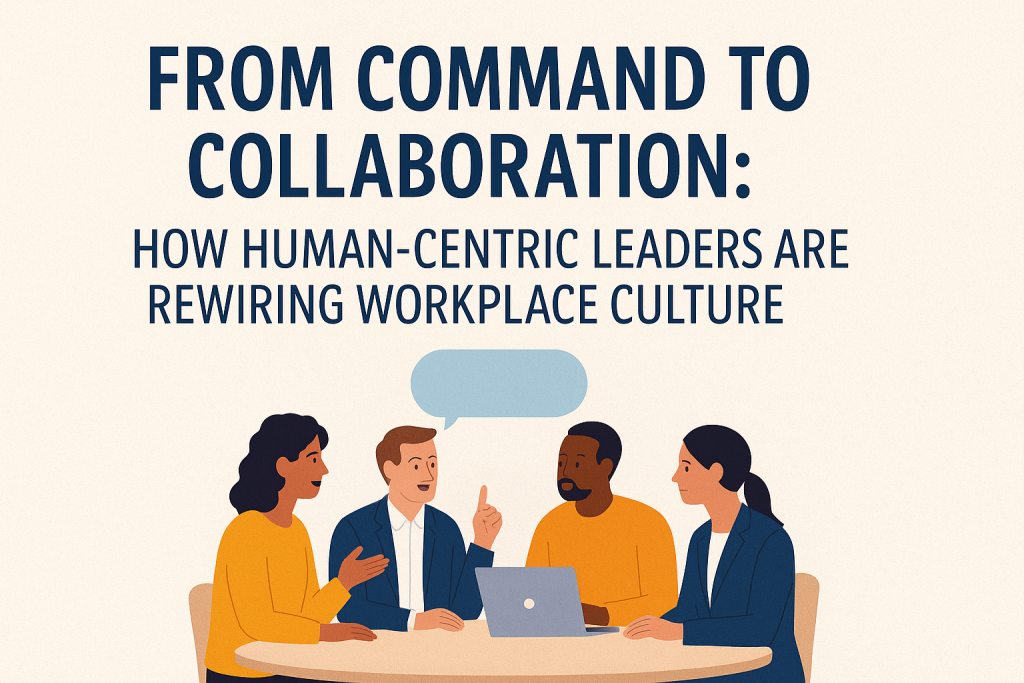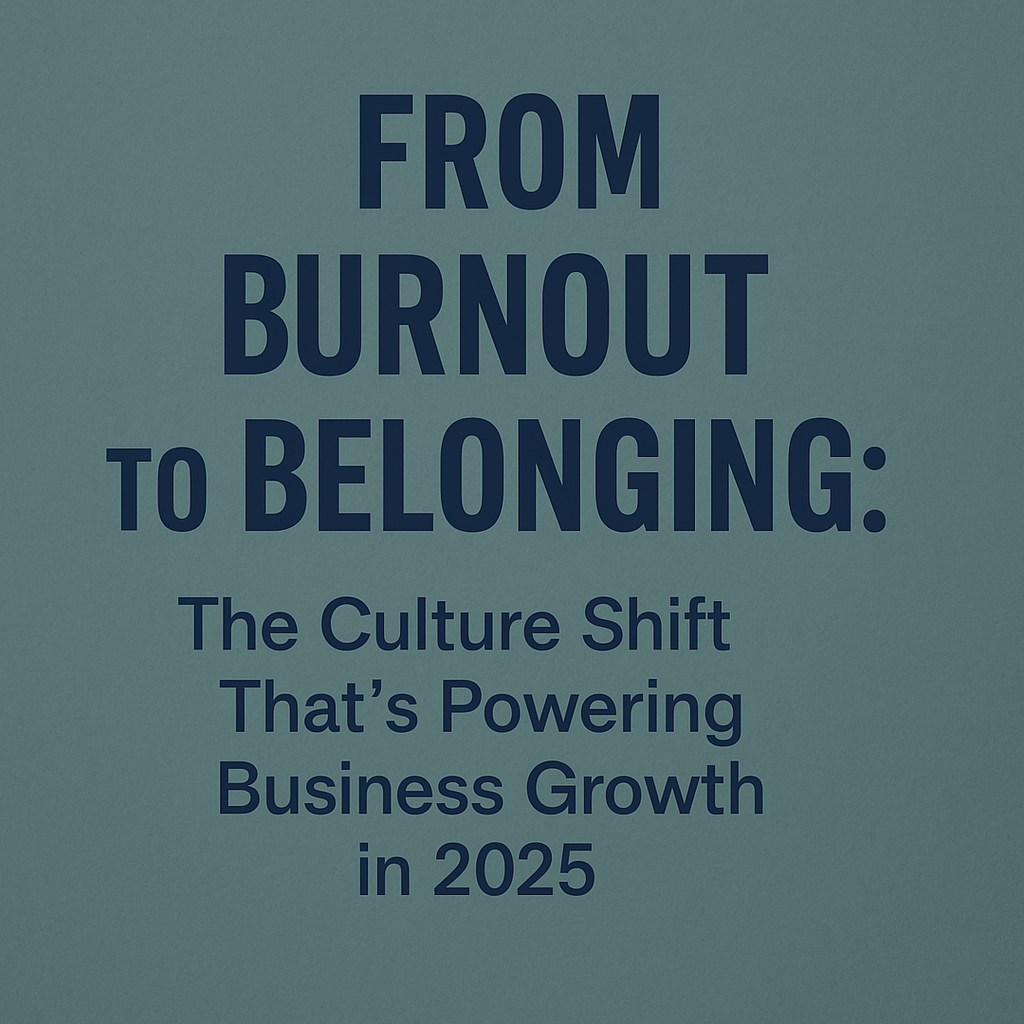In this article, we’ll explore:
What human-centric leadership means in practice
Why the shift from command to collaboration is imperative
The traits and practices of human-centric leaders
The culture transformations this leadership enables
How to start moving your organization in that direction
Pitfalls and challenges to anticipate
Case studies and tangible outcomes
Let’s begin.
What Does “Human-Centric Leadership” Really Mean?
At its core, human-centric leadership is leadership that places people (employees, teams, stakeholders) at the heart of decision making. Rather than viewing workers as units of production or cogs in a machine, human-centric leaders see them as full human beings—with aspirations, challenges, emotions, and unique strengths.
Some key elements:
Empathy & psychological safety: Leading with curiosity, listening deeply, acknowledging emotional states, and intentionally designing environments where people feel safe to speak, err, and experiment.
Shared purpose and meaning: Aligning work with values and mission so that people see how their contributions matter.
Autonomy and empowerment: Enabling teams to make decisions, self-organize, and take ownership.
Collaboration over hierarchy: Flattening decision pathways, encouraging cross-functional teamwork, and distributing influence.
Growth mindset and continuous feedback: Supporting development, acknowledging failure as learning, and providing ongoing coaching rather than judgment.
Transparency and trust: Sharing information, rationale, constraints, and inviting participation in decisions.
Where traditional leadership emphasizes conformity, control, and enforcing compliance, human-centric leadership emphasizes connection, growth, and co-creation.
Why the Shift from Command to Collaboration Is No Longer Optional
The Limitations of Command Leadership
For decades, especially in industrial and early corporate eras, command-and-control was effective: clear chains of authority, predictable processes, and stable environments. But today:
Dynamic environments and complexity: Rapid change, ambiguous problems, and volatility require adaptability, not rigid plans.
Diverse, multigenerational workforce: Employees expect meaning, autonomy, and respect—not hierarchical direction.
Talent scarcity and mobility: High performers can choose where to work. A culture of trust and respect is a competitive advantage.
Innovation demands: New ideas often emerge from the edges. A strict top-down model stifles experimentation and slows adaptation.
Burnout and disengagement crisis: Control fosters stress, compliance, and fear; human focus fosters energy, agency, and commitment.
In other words: command leadership may still work in certain high-risk, crisis, or compliance environments, but it is insufficient—and often counterproductive—for building sustainable, adaptive organizations.
The Case for Collaboration
Shifting to collaboration brings multiple upsides:
Increased engagement and retention
When people feel heard, respected, and empowered, they show up more fully—and are less likely to depart.
Better decision quality
Diverse perspectives, shared understanding, and open debate lead to more robust outcomes.
Faster learning cycles
Teams can test, iterate, and adapt more quickly than if every decision waits for executive sign-off.
Stronger culture and identity
Culture is a lived experience. When people are active participants in shaping it, it becomes authentic, vibrant, and self-reinforcing.
Scalability through ownership
Leaders cannot oversee everything. Distributing influence and accountability lets organizations scale without collapse.
Resilience under stress
In turbulence, tightly knit, trust-based teams adapt more successfully than rigid command systems.
In sum: the shift from command to collaboration is not just ethical or trendy—it’s strategically essential.
Traits and Practices of Human-Centric Leaders
How do you live human-centric leadership? Below are the traits, mindsets, and practical techniques that distinguish leaders who are successfully rewriting culture.
1. Curiosity & Humility
Approach conversations with genuine curiosity about others’ experiences and perspectives.
Mindfully question assumptions (including your own).
Be willing to be wrong, to ask questions, to learn from those you lead.
2. Active Listening & Presence
Practice “listening to learn,” not listening to respond.
Quiet inner judgment and agenda, so you can hear what others are really saying.
Use pauses, reflective summaries, clarifying questions.
Be present—avoid multitasking, interruptions, or distractions in conversations.
3. Purpose-Centered Framing
Instead of dictating tasks, frame work in terms of purpose, mission, and impact.
Clarify the “why” behind work, connect it to values and vision.
Invite others to contribute to that mission narrative.
4. Distributed Authority & Empowerment
Delegate not just execution but decision rights.
Coach and support rather than micromanage.
Define guardrails and boundaries, then let teams operate within them.
Encourage cross-functional, self-organizing teams.
5. Transparent Communication & Openness
Be open about business constraints, trade-offs, and risks.
Share relevant data, metrics, and feedback with the broader team.
Model vulnerability (e.g. admit mistakes, uncertainties).
Invite critique and feedback upward, sideways, and downward.
6. Feedback & Growth Orientation
Embed continuous, two-way feedback loops (informal check-ins, pulse surveys, coaching).
Normalize experimentation, failure, and iterative learning.
Invest in development—coaching, mentoring, training, stretch assignments.
7. Caring for the Whole Person
Recognize employees’ lives, challenges, and well-being (mental, emotional, physical).
Integrate practices like flexible schedules, wellness support, belonging initiatives.
Demonstrate empathy especially in difficult moments.
8. Rituals & Cultural Anchors
Use rituals, symbols, stories, and shared traditions to reinforce relational norms (e.g. daily check-ins, peer recognition, team storytelling).
Celebrate collaboration, not just individual achievement.
Encourage small acts of care (welcoming, check-in texts, informal cohesion).
How Human-Centric Leadership Rewires Culture — A Stages Framework
Culture is not changed overnight. Here’s a rough progression showing how leadership practices translate into cultural transformation over time:
| Stage | Leadership Focus | Cultural Indicators |
|---|
| 1. Intent & Discovery | Leaders examine current culture, solicit input, build alignment for change | Openness in listening, diagnosis, humility, curiosity |
| 2. Modeling & Pilot | Leadership experiments with transparency, collaboration, shared decision making | Small teams experimenting; early wins; safe failures |
| 3. Scaling & Diffusion | Practices are institutionalized across teams, norms reinforced | Cross-team collaboration, shared practices, visible role models |
| 4. Embedded & Self-Sustaining | Culture carries itself; new hires absorb norms intuitively | Peer coaching, cultural onboarding, evolving refinement |
As you move through these stages, the cultural signals shift:
You’ll see more psychological safety: people raise difficult issues, surface concerns, admit when they don’t know.
Networked conversations replace top-down mandates.
Learning orientation becomes normal; experiments and iterations are expected, not punished.
Peer influence grows: people coach each other, hold each other to standards, celebrate collaborative behaviors.
The belief system shifts: Leaders are less “commanders” and more “servant catalysts.”
Getting Started: Steps to Transition
Transitioning from command to collaboration is a journey. Here are practical steps to get started:
1. Start with Self-Awareness & Mindset Shift
Reflect on your own assumptions, triggers, fears, and control needs.
Seek coaching or peer reflection to expand perspective.
Commit publicly to shifting your style.
2. Build a Coalition of Change Agents
Identify early adopters or influence leaders in the organization.
Work with them to pilot new practices.
Use their success stories to build momentum.
3. Create Safe Space for Dialogue
Host listening sessions, culture diagnostic surveys, small group focus groups.
Ask open questions: “What do you need more of?” “Where do you feel stifled?” “What would help us trust one another more?”
4. Launch Pilot Interventions
Pick a team or project to experiment with new ways of working—e.g.:
Shared leadership in decision making
Daily or weekly “check-in” circles
Rotating facilitation and meeting ownership
Transparent metrics dashboards
Cross-functional collaboration pods
Track progress, learn, adapt.
5. Provide Training & Coaching
Training in emotional intelligence, conflict resolution, facilitation, feedback practices.
Coaching for managers to adopt human-centric behaviors.
Peer reflection groups (e.g. “leadership circles”) for sharing practice.
6. Design Structural Reinforcements
Adjust performance reviews, reward systems, and recognition to value collaboration, shared work, learning—not just individual results.
Incorporate new rituals (e.g., retrospectives, peer recognition, open Q&A townhalls).
Align policies (flexibility, autonomy, remote work) with human-centric values.
7. Monitor, Iterate, Celebrate
Use pulse surveys, engagement metrics, 360 feedback to track how culture is changing.
Celebrate micro wins and stories of collaboration in action.
Be ready to course-correct based on feedback.
Keep transparency about what’s working, what’s not, and next steps.
Challenges & Pitfalls to Anticipate
Transitioning culture is complex. Here are risks and how to manage them:
Resistance to Change
Some leaders, long used to commanding, may resist giving up control. Others may fear ambiguity or lack clarity around new roles.
Mitigation: Engage skeptics in dialogue, start small, surface real fears, provide support and training.
Tokenism or Superficial Gestures
Changing surface practices (e.g. lunches, ping-pong tables) without altering power structures or behaviors leads to cynicism.
Mitigation: Focus first on shifting mindset and decision rights, not just aesthetics.
Metrics Overemphasis
Rushing to metrics and oversight can reintroduce command logic under new labels.
Mitigation: Focus on qualitative feedback, narrative stories, and balanced metrics. Give teams space to self-monitor rather than centrally control.
Uneven Adoption Across Teams
Some teams may embrace collaboration more readily; others lag behind, creating friction or silos.
Mitigation: Celebrate early adopters, provide support structures, use storytelling and peer mentoring across teams.
Leadership Fatigue & Wearout
Leaders must sustain new behaviors even under stress. It’s easy to slip back into command when things get tough.
Mitigation: Build peer support groups, create accountability, reflect regularly, and maintain humility.
Misalignment with External Constraints
In regulated industries or mission-critical operations, strict controls may still be required in parts of the organization. The challenge is balancing flexibility with necessary guardrails.
Mitigation: Use hybrid models: embed autonomy where possible, and clarity/structure where needed. Clearly define boundaries.
Case Studies & Outcomes
Here are a few real or illustrative examples (adapted) showing how human-centric leadership has transformed culture:
Case Study A: Tech Startup
A growing software startup had begun fracturing under leadership bottlenecks. The CEO invited the leadership team into a three-month pilot to shift decision making to smaller teams. Over that period:
Product teams made decisions autonomously on feature priorities.
Monthly “listening circles” surfaced bottlenecks early.
The startup saw a 20 % uptick in employee satisfaction and a 15 % increase in velocity of feature delivery.
The leadership team shifted to a role of “orchestration” instead of microcontrol.
Case Study B: Manufacturing Company
A mid-sized manufacturing firm in transition from heavy legacy culture to innovation orientation:
The executive team began sharing financials and forecasts with all levels.
Cross-functional “innovation pods” were launched, empowered to propose new process improvements.
Over two years, employee turnover dropped by 25 %, and new innovations delivered cost savings that paid for the transformation investment.
Case Study C: Nonprofit & Social Sector
In a mission-driven nonprofit, leadership embraced human-centric practices to engage staff:
Weekly check-ins included space for personal sharing (not just work).
Staff rotated facilitation of meetings and retreat planning.
Quiet, historically marginalized voices were invited to co-design programs.
As a result, staff morale rose, and donor feedback improved as teams became more aligned and adaptive.
These stories show what’s possible—not guarantee every organization’s path looks the same. But the outcomes consistently include stronger engagement, innovation lift, reduced turnover, and more resilient culture.
How to Sustain the Change
Culture, once established, must still evolve. Here are principles for sustaining a human-centric, collaborative workplace:
Onboard for culture — from day one, new hires experience collaborative norms, rituals, and values.
Peer coaching and communities of practice — employees support one another in embedding collaboration.
Refresh and revisit — the culture conversation should evolve (not be static) as teams grow, market conditions shift, and leaders change.
Adaptive feedback loops — continue to listen, learn, iterate; abandon what’s not working and double down on what is.
Cultivate leadership at all levels — not just the formal tier. Encourage informal leaders, influencers, and cultural ambassadors.
Guard against complacency — even high-trust cultures can fall back under stress. Regular renewal is essential.
The Bigger Picture: Impact Beyond the Workplace
When human-centric leadership permeates organizations, the ripple effects extend beyond the walls:
Increased social capital: stronger collaboration with partners, stakeholders, communities.
Better reputation and brand: organizations known for care and human values attract customers, talent, and goodwill.
Sustainability and resilience: cultures built on trust and adaptability weather disruption more robustly.
Positive societal shift: as workplaces humanize, broader systems of dominance and hierarchy may loosen—contributing to more humane economies.
The transition from command to collaboration is not a fad, a buzzword, or a soft “nice to have.” It’s a profound shift in how we understand leadership, work, and human flourishing. In knowledge economies, creativity, adaptability, and emotional intelligence are as vital as technical skill. Leaders who cling to old command paradigms may find themselves outpaced by more humane, agile, and collaborative organizations.
Starting this journey takes courage, humility, and persistence. It means examining our beliefs, inviting feedback, delegating authority, and sustaining new behaviors long enough to see culture evolve. But the rewards are powerful: workplaces where people thrive, innovation blossoms, and purpose endures.
Start with yourself. Model empathy, open dialogue, and small shifts. Build allies. Pilot experiments. And let the culture reshape you and your organization together.
If you’d like help drafting a roadmap, workshop agenda, or change plan to bring human-centric leadership into your organization, I’d be happy to assist.










